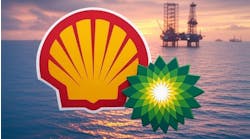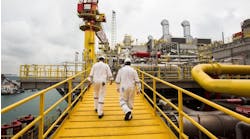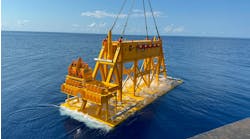Firm also plans deepwater riser, mooring division
Jon Erik Reinhardsen has become managing director of newly established Aker Geo.Aker Geo, the seismic company launched earlier this year by Aker Maritime, is now in the throes of getting itself up and running. In the course of the next few years it aspires to become one of the world's four largest seismic companies.
The recruitment of outside staff to join those drafted in from within the group is underway. By year-end, there will be a staff of about 25, a number which will more or less double by end-1999, according to managing director Jon Erik Reinhardsen.
In the next few weeks, the company plans to buy a hull under construction, which it will convert into its first seismic vessel, possibly at Aker Finnyards in Finland. The first couple of vessels will be conversions, Reinhardsen says - this will enable the company to start seismic acquisition operations in summer 1999.
It will also build new vessels, and plans to have a fleet of four to six vessels in operation over the next three to five years. Design of the newbuilds is being carried out by the group company Maritime Trosvik, which in the past has designed more than 30 seismic vessels.
The company is also in the process of selecting shipowner partners. This will enable it to share the large investment - around NKr 2 billion - needed to build the fleet. The shipowner partners will own the vessels and provide the marine crews, leaving Aker Geo to provide the seismic crews and equipment.
Aker Geo is also likely to go public in the next couple of years. "This is an area which requires a lot of financing, so we need to bring in other sources of finance," says Reinhardsen. At present, it is owned 51% by Aker Maritime and 49% by Aker RGI, the group's majority owner.
Though heavy investments are required, the potential prize is also impressive - a share of a global market worth NKr 15-20 billion annually. Other attractions include few players, strong growth, and good margins.
For the time being, Aker Geo constitutes a new business area - the sixth - within Aker Maritime. The group took its first step into this new area of activity early this year with the acquisition of the Stavanger-based geology company JSI, which has a staff of about 50. JSI has now become a subsidiary of Aker Geo, and will change its name to Aker Geo Petroleum Services.
Aker Geo's focus will be on applying technology. Equipment such as streamers will be bought, leaving the company to develop geoscientific skills such as reservoir modeling and simulation and geological interpretation. "We see this as a life-of-field service, which fits in with the group's overall strategy of providing life-of-field services," says Reinhardsen.
There will also be opportunities to link in with other areas of expertise within the group, most notably with the downhole skills offered by Maritime Well Service, with which Reinhardsen sees Aker Geo developing a close cooperation.
Riser division
Parent company Aker Maritime has also established a new technology company to develop and deliver risers and mooring systems for deep-water field developments.Aker Riser Systems AS will fill what the company sees as a strategic gap in its ability to deliver turnkey floater solutions for deepwater fields. "We have all the floaters - semisubmersibles, production ships, tension-leg platforms, and so on," says managing director Odd Arvid Olsen. "Whether they get utilized in deepwater depends totally on finding solutions for the risers and mooring systems."
Solutions already exist for waters down to 1,500-2,000 meters, but beyond these depths, new technology is required, says Olsen, who was previously involved in offshore research and development projects in his position as vice president at DNV.
The new company, which was registered in May, has offices in Oslo and Bergen. Initially there will be about 15 staff in each location. As part of the group's EPC Norway business area, it will take responsibility for the risers and mooring systems in all the development projects contracted to Aker Maritime.
It will work closely with Aker Maritime companies in the US, where developments in the Gulf of Mexico are already taking place in waters beyond 1,500 meters. Aker Maritime is currently performing detailed engineering for a deep draft caisson vessel, a spar-type buoy, for Exxon's Diana Field, which lies in 1,460 meters water depth.
In northwest Europe, deepwater discoveries have recently been made in water depths approaching 1,300 meters in the Norwegian Sea. The conditions here are in general much more demanding than in the Gulf of Mexico, with much higher environmental loading on subsurface production facilities.
Aker Riser Systems' focus will be primarily on risers, including flexible, rigid and catenary systems. Mooring systems form part of the company's remit as the technical challenges associated with the two products are similar, Olsen says.
"Our ability to solve some of the deepwater challenges will very much depend on our ability to develop new and lighter materials," he says. The main new materials under consideration for deepwater risers are titanium and composite materials.
Hitherto floaters have been designed independently of the riser and mooring systems to be used. In very deep water, this will have to change as the weight and size of the riser and mooring systems will be such as to influence, and in some cases, dominate, the floater design, Olsen says. A systems approach is therefore needed in which the whole system needs to be optimized for a certain location and interactions between the various system parts need to be addressed.
The search for solutions may involve the development of completely new concepts, based either on the utilization of new materials or new functional principles. "For instance, it may not be feasible for floaters to support the weight of both risers and mooring systems," Olsen says. "We may see that mooring through the risers becomes a feasible concept, and free-standing and hybrid riser systems may be installed."
In July, the company began work on its first contract, conceptual engineering of a 27-in. titanium catenary gas export riser for Statoil's Åsgard B platform, which will be installed in some 350 meters of water. It is also considering business proposals for developing new composites.
Copyright 1998 Oil & Gas Journal. All Rights Reserved.




